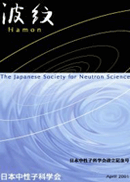
- Issue 4 Pages 192-
- Issue 3 Pages 130-
- Issue 2 Pages 77-
- Issue 1 Pages 3-
- |<
- <
- 1
- >
- >|
-
Nobuyuki Kurita, Hidekazu Tanaka2020Volume 30Issue 3 Pages 130-135
Published: August 10, 2020
Released on J-STAGE: December 01, 2021
JOURNAL FREE ACCESSWe have studied magnetic excitations of the effective spin S = 1/2 dimerized magnet Ba2CoSi2O6Cl2 directly via inelastic neutron scattering experiments. Observed five types of magnetic excitations are all dispersionless within the resolution limits. Unexpected observation is that the three low-lying excitations exhibit different Q dependencies of scattering intensities. Detailed analysis has demonstrated that Ba2CoSi2O6Cl2 is a two-dimensional spin dimer system where the triplet excitations are localized owing to the almost perfect frustration of the interdimer exchange interactions and the undimerized spins produced by vacancies in the crystals, even in small concentration, have an essential effect on the excitation spectra.
View full abstractDownload PDF (1796K) -
Kazuki Iida2020Volume 30Issue 3 Pages 136-139
Published: August 10, 2020
Released on J-STAGE: December 01, 2021
JOURNAL FREE ACCESSLi2AMo3O8 (A = In or Sc) is a molecular based spin-1/2 triangular lattice system where spin-1/2 Mo3O13 clusters in place of Mo ions form the uniform triangular lattice. Their ground states are different according to the A site. Li2InMo3O8 undergoes conventional 120° long-range magnetic order below TN = 12 K whereas isomorphic Li2ScMo3O8 exhibits no long-range magnetic order down to 0.5 K. Here, we report exotic magnetisms in Li2InMo3O8 and Li2ScMo3O8 investigated by inelastic neutron scattering (INS) using polycrystalline samples. Li2InMo3O8 and Li2ScMo3O8 show completely different INS spectra, representing their different ground states. Li2InMo3O8 exhibits spin wave excitation which is quantitatively described by the nearest neighbor anisotropic Heisenberg model based on the 120° spin structure. In contrast, Li2ScMo3O8 undergoes short-range magnetic order below 4 K with quantum-spin-liquid-like magnetic fluctuations down to the base temperature. Origin of the different ground states is discussed in terms of anisotropies of crystal structures and magnetic interactions.
View full abstractDownload PDF (1255K) -
Shohei Hayashida, Takatsugu Masuda2020Volume 30Issue 3 Pages 140-143
Published: August 10, 2020
Released on J-STAGE: December 01, 2021
JOURNAL FREE ACCESSA pressure-induced quantum phase transition in the triangular antiferromagnet CsFeCl3 has been studied by means of both triple-axis and time-of-flight neutron spectrometers. Inelastic neutron scattering experiments were performed to measure entire spin spectra through the transition and their pressure dependence. It is demonstrated that in the quantum disordered phase, the magnetic excitation is softened by applying pressures. A spin wave excitation is observed in the ordered phase. Calculation of the spin spectra proves that the transverse and longitudinal spin fluctuations are hybridized in the ordered state. In addition, it is found that the hybridization is remarkably enhanced near the quantum critical point.
View full abstractDownload PDF (871K) -
Yukako Fujishiro, Naoya Kanazawa2020Volume 30Issue 3 Pages 144-148
Published: August 10, 2020
Released on J-STAGE: December 01, 2021
JOURNAL FREE ACCESSWe report topological magnetic phase transitions between skyrmion lattice state and hedgehog lattice state realized in cubic chiral magnets MnSi1-xGex. By performing small- and wide-angle neutron scattering experiments, we discover three different topological spin textures with variation of the lattice constant controlled by Si/Ge substitution: skyrmion lattice (x = 0-0.25) and two types of hedgehog lattices with four q-vectors (x = 0.4-0.6) and three q-vectors (x = 0.7-1.0). The variation of magnetic properties in MnSi1-xGex strongly suggests that short-period hedgehog lattices may be stabilized by conduction electron mediated exchange interactions, rather than Dzyaloshinskii-Moriya interaction. We also discuss some recent theoretical proposals concerning the stabilization mechanism of the hedgehog lattices, which are related to high-order exchange interactions.
View full abstractDownload PDF (1423K) -
Minoru Soda2020Volume 30Issue 3 Pages 149-153
Published: August 10, 2020
Released on J-STAGE: December 01, 2021
JOURNAL FREE ACCESSMagnetic excitation mode in the multiferroic Ba2CoGe2O7 are clarified by the unpolarized and polarized neutron scattering measurements. The unpolarized neutron spectrum reveals the existences of two dispersive excitations below 2.5 meV and one dispersionless excitation at 4 meV. By analyzing the polarized neutron spectra, the mode of the observed three excitations are identified. Three fluctuations, the transverse fluctuation in the a-b plane, that in the c-direction, and the longitudinal fluctuation of the ordered moment, are involved in the magnetic excitation of Ba2CoGe2O7. The determined modes are consistent with the calculation by the extended spin-wave theory. The longitudinal fluctuation takes on a main role in the electromagnon mode of Ba2CoGe2O7.
View full abstractDownload PDF (1116K) -
Anibal J Ramirez-Cuesta, Yongqiang Cheng2020Volume 30Issue 3 Pages 154-159
Published: August 10, 2020
Released on J-STAGE: December 01, 2021
JOURNAL FREE ACCESSInelastic Neutron scattering (INS) is a very powerful tool to study the vibrational dynamics of solids. The VISION spectrometer at the SNS in Oak Ridge Tennessee has an increased overall flux at low energy transfers up to 100 times over its predecessors and it has unprecedented sensitivity. We will examine the limits of what is now possible in INS thanks to VISION. From the determination of INS spectra of publishable quality in minutes (for samples in the gram quantity range), measuring the signal of samples in the milligram range to the direct determination of the signal of 2 mmol of CO2 adsorbed on functionalized catalysts. Finally, the major challenges that we are facing will be discussed, in particular methods to automate data analysis and interpretation through computer modelling and Artificial Intelligence/Machine Learning etc.
View full abstractDownload PDF (1101K) -
Koji Kaneko, Masashi Kakihana, Masato Hedo, Takao Nakama, Yoshichika Ō ...2020Volume 30Issue 3 Pages 160-165
Published: August 10, 2020
Released on J-STAGE: December 01, 2021
JOURNAL FREE ACCESSMagnetic properties of trillium lattice antiferromagnet EuPtSi, crystallizing in the same group as archetypical skyrmion compound MnSi, were investigated. Single crystal neutron diffraction revealed a close similarity between two compounds, despite a difference in periodic length. The result implies that EuPtSi is the first 4f electron magnet to host magnetic skyrmion lattice.
View full abstractDownload PDF (797K)
- |<
- <
- 1
- >
- >|